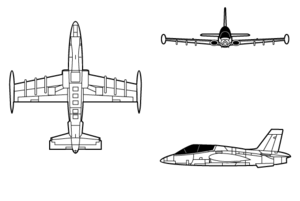MB-339
Summary
| Category | Military Training Aircraft |
| Origin country | 🇮🇹 Italy |
| Manufacturer | Aermacchi |
| First flight | 12 August 1976 |
| Year introduced | 1979 |
| Number produced | 230 units |
Description
The Aermacchi MB-339 was developed during the 1970s in response to an Italian Air Force requirement for a replacement for its Aermacchi MB-326 and Fiat G.91T fleets. Aermacchi received a contract in September 1972 to study potential replacements, evaluating seven new designs against an improved version of the MB-326, designated MB-339. The MB-339 was selected in 1975. The prototype, designated MB-339X, first flew on 12 August 1976. The first production-standard aircraft followed in July 1978, and deliveries of the MB-339A to the Italian Air Force commenced the following year, with 101 aircraft inducted between 1978 and 1987. Aermacchi subsequently developed improved models, including the MB-339K Veltro II single-seat attack variant, which first flew in 1980; the MB-339B with light-attack capability, entering service in 1985; and the refined MB-339C, a dual-use aircraft that first flew the same year. In the late 1980s, the enhanced MB-339C, featuring a modernized cockpit, became available. The Italian government procured the MB-339CD, equipped with a digital cockpit and a fixed probe for aerial refueling training.
The Aermacchi MB-339 is a military jet trainer and light attack aircraft featuring a conventional configuration, tricycle undercarriage, and all-metal construction. It shares a significant portion of its airframe with the MB-326. A notable design change is a redesigned forward fuselage to improve visibility for the instructor seated behind the student pilot. The aircraft accommodates a crew of two in tandem, with a pressurized cockpit and a jettisonable canopy integrated with twin Martin-Baker ejection seats. It features a low, unswept wing identical to that of the MB-326K, complete with tip tanks and air intakes for the single turbojet engine located within the wing roots. Initial versions were equipped with the Rolls-Royce Viper 632-43 turbojet engine, producing 4,000 lbf of thrust. Later models like the MB-339C incorporated the more powerful Viper 680 engine, generating up to 4,300 lbf of thrust. The MB-339 also features an enlarged tailfin for improved aerodynamics compared to its predecessor.
The MB-339 can be equipped for combat roles. Combat-oriented aircraft feature advanced avionics such as improved inertial guidance systems, digital nav/attack computers, a MIL-STD-1553B databus, and HOTAS-compatible flight controls. Defensive systems can be added, including a radio jammer, radar warning receiver (RWR), and electronic countermeasures (ECM), along with larger wingtip tanks. The MB-339K variant carries two 30mm DEFA cannons. The aircraft has six underwing hardpoints capable of accommodating up to 1,815 kilograms (4,000 lb) of external stores. It is qualified to carry munitions including the Sidewinder and R.550 Magic air-to-air missiles, the AGM-65 Maverick air-to-surface missile, various laser-guided bombs and rockets, and the Marte Mk.2 anti-ship missile. Provisions existed for the installation of two pod-mounted 30mm cannons.
The Italian Air Force is the largest operator of the MB-339, having procured multiple batches and models since 1978 for use as its principal trainer aircraft and flown by the Frecce Tricolori aerobatic display team. Other operators, such as the Royal New Zealand Air Force, acquired the type in the 1980s and 1990s to replace aging jet-powered attack aircraft. Some export customers, such as the United Arab Emirates, utilize the aircraft for aerobatic displays. The Argentine Naval Aviation utilized the MB-339A during the Falklands War, operating them as attack jets from Port Stanley Airport and naval air stations on the mainland. Eritrea ordered six MB-339CEs in 1996, subsequently deploying them in combat during the Eritrean-Ethiopian War for attacks on cities and strategic sites. The MB-339CD model remains a viable training platform.
Main Variants:
-
MB-339A: The original production variant used primarily by Italy and exported to nations such as Ghana and the UAE as a trainer.
-
MB-339PAN: A specialized variant for the Frecce Tricolori aerobatic team, featuring a smoke generator and lacking tip tanks for enhanced maneuverability.
-
MB-339K Veltro II: A single-seat dedicated attack version with enhanced combat capabilities, with only one built.
-
MB-339CD: A modernized version developed for Italy with updated flight controls and avionics, retaining the Viper 632-43 engine for enhanced training.
-
MB-339CE: An export version of the MB-339C supplied to Eritrea, powered by the Viper 680-43 engine.
Technical specifications
| Version: MB.339A | |
|---|---|
| Maximum speed | 898 km/h (558 mph) |
| Wing area | 19 m² (204.5 sqft) |
| Wingspan | 10.9 m (35.6 ft) |
| Height | 3.6 m (11.8 ft) |
| Length | 11.0 m (36.0 ft) |
| Service ceiling | 14,630 m (47,999 ft) |
| Empty weight | 3,075 kg (6,779 lbs) |
| Max. takeoff weight | 5,897 kg (13,001 lbs) |
| Climb rate | 33.5 m/s (109.9 ft/s) |
| Powerplant | 1 x turbojet Rolls-Royce Viper 632 delivering 1814 kgf each |
| Ejection seat | Martin-Baker Mk 10 |



